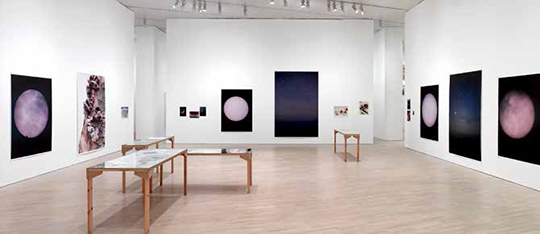WOLFGANG TILLMANS
| September 21, 2013 | Post In LEAP 22

K21 Ständehaus, Düsseldorf
PHOTO: Achim Kukulies Courtesy of Kunstsammlung NRW
This large-scale retrospective of the famous German photographer and Turner prize winner Wolfgang Tillmans (b. 1968) provided a complete tour through his enormously versatile oeuvre. Tillmans is known for his unpretentious and innovative works of photography, which have continuously explored concepts beyond new techniques for and presentation of this (by now near-historical) medium. Some early photographs and even drawings are on view for the first time in the Isabelle Malz-curated exhibition, together with many works from the 1990s showing his young friends and the sub/club culture Tillmans grew up with. Beside those seemingly casual photographs, with their documentary character and atmospheric intimacy marked by a keen perceptivity and feel of contemporariness that became his trademark, the exhibition offered a non-linear view through Tillmans’ wide range of subject matter and working methods.
The “Venus Transit” series (2004) and the accompanying table installations (Kepler Venice Tables, 2009) show both large-scale images of the significant scientific event that Tillmans documented through a telescope, as well as “further reading” of the images and texts presented on the tables. Serving at once as an information source and a reminder of the contingency of objective facts, these address the forms of reproduction and distribution of knowledge, which—as the other table installations of Truth Study Centre and their sociopolitical issues show—are part and parcel of our whole system of mass communication, propaganda, and opinion-forming mechanisms. However, the critical framework also reveals spaces of individual action and life within the media-dominated modern world, where the viewer recognizes his/her own familiar context in the maze of contemporary press material.
The question of photographic representation and its forms of reception through media and distribution, as well as the change of format and image substrates that come with this process, is a constant element in Tillmans’ artworks. From the newspaper copies of Soldiers: The Nineties (1999), where he considers the media phenomenon of soldier portraits in war reports, to the numerous photographic wall installations of disparate landscapes, urban spaces, public events, portraits, and still lives both spontaneous and elaborately composed, Tillmans demonstrates a great awareness of site-specific situations in the exhibition space. Dialogues between “naked” images simply pinned to the wall are stimulated by carefully arranged constellations, shifting positions, and varying picture sizes, thus allowing new associations and readings of the individual works.
Tillmans’ photographic practice always proves to be more than just image-making. Rather, it is an all-encompassing art practice that reflects our relationship to a pictorial world that has become our quotidian environment and reality. The diversity and richness of visual phenomena is matched by the fluid mobility and convertibility of their pictorial representations, providing us visually-trained contemporaries with an encyclopedic vista in the ubiquitous presence of (photographic) images. This aspect does not only apply to exhibition presentation, but is also carried on in Tillmans’ numerous artist books.
The terms of photography as a technical medium is a substantial question the artist continues to contemplate throughout his oeuvre, ranging from his early works on digital copying machines, black-and-white photocopy series, to the later fully abstract photographs of the “Lighter” series (from 2006) and the large-scale “Freischwimmer” series (from 2004), which were made in the darkroom without using a camera. Their intense colors and enigmatic imagery bring to mind the material substrate of photography, recalling the technical essence of its chemical processes in an age of digitalization. The alchemistic wonder of these works is both a romantic vision and a conceptual self-reflection. The overwhelming aesthetics of the huge format push the boundaries of photography, while physically swallowing up the viewer within its pictorial depth.
The free catalogue offered to every visitor of the exhibition (both online and printed) seems to meet Tillmans’ concept: While images are always transferrable and available, each specific version and format—whether digital, printed, or projected—creates yet another encounter and experience, allowing new aesthetic and narrative readings to emerge.

